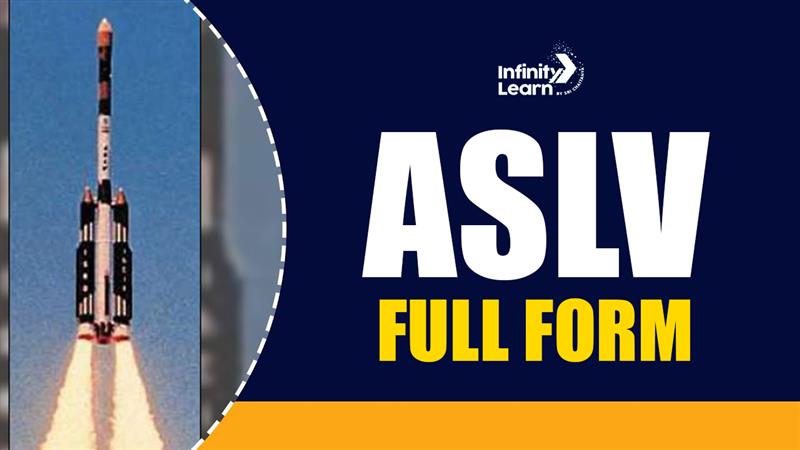Table of Contents
ASLV stands for Augmented Satellite Launch Vehicle (ASLV). The Augmented Satellite Launch Vehicle (ASLV) was a small rocket made by ISRO to send small satellites into space. It was used between 1987 and 1994 and had four stages that helped it fly high. The ASLV was an important step for India to learn more about space technology. Even though not all launches were successful, it helped ISRO build stronger rockets like PSLV and GSLV later.

What is ASLV?
The Augmented Satellite Launch Vehicle (ASLV) was a small rocket made by ISRO (Indian Space Research Organisation). It was used to send small satellites into space, especially into low Earth orbit. ISRO used this rocket five times between 1987 and 1994.
The ASLV had four stages. The first three stages used solid fuel, and the last stage used liquid fuel to carry the satellite into space. It could carry satellites that weighed up to 150 kilograms and place them about 600 kilometres above Earth.
The ASLV helped launch small science and test satellites for India and other countries. In 1994, ISRO stopped using ASLV because better and stronger rockets like the PSLV (Polar Satellite Launch Vehicle) and GSLV (Geostationary Satellite Launch Vehicle) were made.
Do Check: List of all Important Full Forms
History of ASLV
The Augmented Satellite Launch Vehicle (ASLV) was a special rocket made by ISRO (Indian Space Research Organisation). ISRO started working on the ASLV in 1979 and used it until 1994. This rocket was made to carry small satellites into low Earth orbit (which means not too far from Earth).
The ASLV had four parts (called stages) that helped it fly into space. It used solid fuel in these stages. The rocket could carry a satellite that weighed about 150 kilograms. Check the following details about the five ASLV missions:
- ASLV-D1: Launched on March 24, 1979, from Sriharikota. This rocket did not reach space because its fourth stage did not work properly.
- ASLV-D2: Launched on July 13, 1981. This rocket also failed, as there was a problem in the second stage.
- ASLV-D3: Launched on March 22, 1983. This was the first successful ASLV. It placed a small satellite into orbit.
- ASLV-D4: Launched on May 20, 1987. This launch was also successful.
- ASLV-D5: Launched on May 4, 1994. This was the final ASLV launch, and it was successful too.
Even though some launches failed, the ASLV program was very helpful. It taught ISRO many new skills and technologies. These learnings helped India make stronger rockets later, like the PSLV (Polar Satellite Launch Vehicle) and the GSLV (Geostationary Satellite Launch Vehicle).
Also Check: AFCAT Full Form
What is an ASLV Vehicle, and how does it work?
ASLV means Augmented Satellite Launch Vehicle. It was a special type of rocket made by ISRO (Indian Space Research Organisation) during the 1980s and 1990s. The job of this rocket was to carry small satellites into low Earth orbit (which is not very far from the Earth).
The ASLV had four stages. This means the rocket had four parts that helped it fly higher and higher.
- The first and second stages used solid fuel, which works like powerful firecrackers.
- The third and fourth stages used liquid fuel, which helped the rocket move smoothly in space.
All ASLV rockets were launched from the Satish Dhawan Space Centre in Sriharikota, India.
ISRO launched the ASLV five times, and the final mission happened in the year 1994. These rockets helped ISRO learn more about how to launch satellites and build better rockets in the future.
Specification of ASLV
Check these specifications of the Augmented Satellite Launch Vehicle (ASLV):
- Height: 32 meters (as tall as a 10-storey building)
- Width (Diameter): 1.8 meters
- Weight (Mass): 27 tonnes
- Payload Capacity: 150 kilograms (small satellite)
- Stages: 4 (four parts that help the rocket go up)
- Launch Site: Sriharikota, India
- First Launch: March 24, 1987
- Total Launches: 5
- Success Rate: 40% (2 successful launches out of 5)
The ASLV was a four-stage rocket.
- The first three stages used solid fuel to push the rocket up.
- The fourth stage used liquid fuel to move the rocket smoothly in space.
The ASLV had a lift-off power of about 170 tonnes. It could carry small satellites into a round path (circular orbit) about 600 kilometres above the Earth. This rocket was used to send small science and test satellites into space for the Indian government and also for other countries. The ASLV was stopped in 1994, after ISRO made stronger rockets like the Polar Satellite Launch Vehicle (PSLV) and the Geostationary Satellite Launch Vehicle (GSLV).
Must Read: Airbnb Full Form
Launch Statistics of ASLV
Check the simple launch details of the Augmented Satellite Launch Vehicle (ASLV) program below:
- Total number of launches: 5
- First launch date: March 24, 1979
- Last launch date: May 4, 1994
- Success rate: 40% (Out of 5 launches, 2 were successful)
Here are the details of each ASLV launch:
- ASLV-D1: Launched on March 24, 1979. Failed because the fourth stage did not work properly.
- ASLV-D2: Launched on July 13, 1981. Failed due to a problem in the second stage.
- ASLV-D3: Launched on March 22, 1983. Success – it placed a small satellite in space.
- ASLV-D4: Launched on May 20, 1987. Success – it also placed a small satellite in space.
- ASLV-D5: Launched on May 4, 1994. Success – another small satellite was placed in space.
The ASLV rocket was used to test new space technology. It was an experimental rocket, which means it was made for learning and improving.
Later, ISRO made better rockets like the PSLV and GSLV, which had more success in launching satellites.
Types of Launchers of ASLV
The Augmented Satellite Launch Vehicle (ASLV) was a four-stage rocket made by ISRO (Indian Space Research Organisation). It was used to send small satellites into low Earth orbit. Here are the four stages of the ASLV:
- First stage: Used a solid fuel rocket to lift the rocket from the ground.
- Second stage: Also used solid fuel to push the rocket higher.
- Third stage: Used a liquid fuel engine to keep the rocket moving up.
- Fourth stage: Also used liquid fuel to place the satellite in space.
The ASLV was launched from the Satish Dhawan Space Centre in Sriharikota, India. It was made to be a low-cost rocket to launch small satellites into space. It was used for missions like remote sensing and communication. The ASLV program ended in the 1990s, after five missions were completed.
Also Read: ASL Full Form
FAQs on ASLV Full Form
What is the full form of ASLV?
ASLV means Augmented Satellite Launch Vehicle.
What are PSLV, GSLV, and SSLV?
They are Indian rockets made by ISRO to send satellites into space.
Who launched ASLV?
ISRO (Indian Space Research Organisation) launched the ASLV.
How many stages are in ASLV?
ASLV has four stages to help it fly and place satellites in space.









